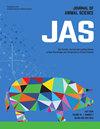全静止物包埋水平影响高羊茅干草体外纤维消化率和瘤胃发酵。
IF 2.7
2区 农林科学
Q1 AGRICULTURE, DAIRY & ANIMAL SCIENCE
引用次数: 0
摘要
随着美国东南部波旁威士忌工业的发展,导致液体蒸馏副产品的产量增加,迫切需要探索整个蒸馏液(含有残余谷物(玉米、黑麦、麦芽)和乙醇分离后的液体)在牲畜营养中的可持续利用。本试验旨在研究增加全贮物包埋量对高羊茅干草体外纤维消化率和瘤胃发酵的影响。试验选用2头安格斯×荷斯坦阉牛(390±4.49 kg BW),饲喂90%高羊茅干草和10%裂谷玉米的基础饲粮,获得瘤胃内容物。从当地一家酿酒厂获得全蒸馏液,进行均质处理,并按0.00%、9.06%、18.1%和36.3% (v/v)的比例替换Goering和Van Soest缓冲液中的水,模拟实际条件下全蒸馏液的瘤胃填充。以高羊茅干草为底物,培养48 h。采用SAS的GLM程序,采用多项式对比语句进行统计比较。增加全贮液添加量可线性降低DM表观消化率(P = 0.002),其中全贮液添加量36.3%时DM和NDF消化率系数最低(P = 0.03)。产气速率和产气量、产甲烷量及总挥发性脂肪酸浓度随全池含气量的增加而增加(P < 0.05)。发酵培养基的终pH值随全液添加量的增加呈线性降低(P < 0.001)。摩尔乙酸、戊酸盐、异戊酸盐和异丁酸盐的比例随着全酒糟添加量的增加而降低(P < 0.05)。摩尔丙酸比例呈二次响应(P < 0.01),峰值出现在全贮液的36.3%。增加全贮液包埋量,发酵培养基中纤维素分解菌和抗2-脱氧葡萄糖纤维素分解菌的活菌数呈线性降低(P < 0.001)。利用多肽和氨基酸的细菌呈线性增加(P < 0.001),高氨产菌浓度在36.3%全贮液时达到峰值(二次曲线:P = 0.05)。在体外瘤胃培养基中增加全静止物包埋量对高羊毛干草的发酵有负面影响,表现为NDF消失、纤维素分解菌、pH和支链VFA比例降低。本文章由计算机程序翻译,如有差异,请以英文原文为准。
Whole stillage inclusion level influences in vitro fiber digestibility and ruminal fermentation of tall fescue hay.
With the growing bourbon industry in the southeastern U.S. leading to increased production of liquid distillery byproducts, there is a pressing need to explore sustainable uses for whole stillage [containing residual grain (corn, rye, malted barley) and liquid after ethanol separation] in livestock nutrition. The objectives of this study were to evaluate the effects of increasing whole stillage inclusion on the in vitro fiber digestibility and ruminal fermentation of tall fescue hay. Ruminal contents were obtained from two ruminally-cannulated Angus × Holstein steers (390 ± 4.49 kg BW) fed a basal diet consisting of 90% tall fescue hay and 10% cracked corn. Whole stillage was obtained from a local distillery, homogenized, and replaced water in the Goering and Van Soest buffer preparation at 0.00%, 9.06%, 18.1%, or 36.3% on a v/v basis to simulate ruminal fill of whole stillage under practical conditions. Tall fescue hay was used as the substrate and vessels were incubated for 48 h. Results were analyzed with the GLM procedure of SAS using polynomial contrast statements for statistical comparison. Increasing whole stillage inclusion linearly decreased (P = 0.002) apparent DM digestibility, with the lowest (quadratic: P = 0.03) coefficients for true DM and NDF digestibility occurring at 36.3% whole stillage inclusion. The rate and extent of gas production, methane production, and total VFA concentration increased (P < 0.05) with increasing whole stillage inclusion. The final pH of the fermentation media linearly decreased (P < 0.001) with increasing whole stillage inclusion. The molar acetate, valerate, isovalerate, and isobutyrate proportions decreased (P < 0.05) with increasing whole stillage inclusion. The molar propionate proportion responded quadratically (P < 0.01), with the peak proportion occurring at 36.3% whole stillage inclusion. Increasing whole stillage inclusion linearly decreased (P < 0.001) the viable number of cellulolytic and 2-deoxyglucose-resistant cellulolytic bacteria in the fermentation media. Peptide- and amino acid-utilizing bacteria increased linearly (P < 0.001) and hyper-ammonia-producing bacterial concentration peaked (quadratic: P = 0.05) at 36.3% whole stillage inclusion. Increasing whole stillage inclusion in the in vitro ruminal media demonstrated negative effects on the fermentation of tall fescue hay, as indicated by decreased NDF disappearance, cellulolytic bacteria, pH, and branched-chain VFA proportions.
求助全文
通过发布文献求助,成功后即可免费获取论文全文。
去求助
来源期刊

Journal of animal science
农林科学-奶制品与动物科学
CiteScore
4.80
自引率
12.10%
发文量
1589
审稿时长
3 months
期刊介绍:
The Journal of Animal Science (JAS) is the premier journal for animal science and serves as the leading source of new knowledge and perspective in this area. JAS publishes more than 500 fully reviewed research articles, invited reviews, technical notes, and letters to the editor each year.
Articles published in JAS encompass a broad range of research topics in animal production and fundamental aspects of genetics, nutrition, physiology, and preparation and utilization of animal products. Articles typically report research with beef cattle, companion animals, goats, horses, pigs, and sheep; however, studies involving other farm animals, aquatic and wildlife species, and laboratory animal species that address fundamental questions related to livestock and companion animal biology will be considered for publication.
 求助内容:
求助内容: 应助结果提醒方式:
应助结果提醒方式:


